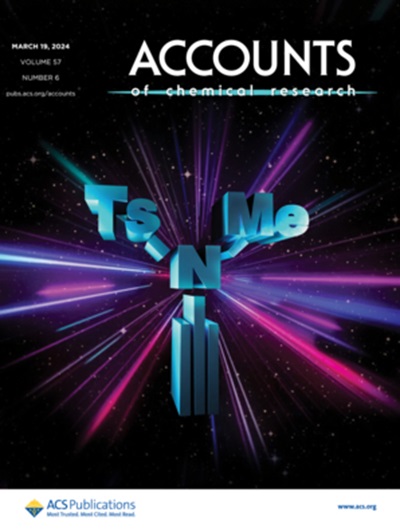Biomolecular Transformations Shape the Environmental Fate of Nanoscale and Emerging Materials.
IF 17.7
1区 化学
Q1 CHEMISTRY, MULTIDISCIPLINARY
引用次数: 0
Abstract
ConspectusEngineered nanomaterials (ENMs) have revolutionized biomedicine, energy, and environmental remediation due to their unique physicochemical properties. However, these properties are not static; they evolve dynamically as ENMs interact with real-world biological and environmental systems. Central to this transformation is the formation of the biomolecular corona, a dynamic layer of adsorbed proteins, lipids, and metabolites that govern how nanomaterials interface with their surroundings. The corona alters the surface chemistry, colloidal stability, and biological identity of an ENM, ultimately dictating its environmental fate, functionality, and safety profile, but also evolves as the surroundings change or as the living system responds to the presence of the nanomaterials and secreted biomolecules.Over the past decade, our research has elucidated how biomolecule-driven transformations, such as dissolution, ion release, sulfidation, enzymatic degradation, and redox reactions, can be modulated by the acquired corona. These processes not only determine the longevity and toxicity of nanomaterials but also offer programmable opportunities for safe degradation or detoxification. For instance, coronas can enhance or suppress ion leaching and catalyze phase changes into less bioavailable forms.We have also explored the role of eco-coronas, formed in environmental matrices like soil or aquatic systems, which contain a broader range of biomolecules beyond proteins, such as humic acids, polysaccharides, and microbial secretions. These coronas initiate transformation cascades as ENMs transition through different environmental compartments, influencing mobility, speciation, and bioavailability to organisms. Through this lens, we view ENMs not as inert entities but as evolving systems shaped by dynamic biological interactions.While the biomolecular corona concept is well-established for engineered nanomaterials such as metal and polymeric nanoparticles, it is now extending to emerging materials such as metal-organic frameworks (MOFs). These hybrid, porous materials are increasingly used in biomedical, catalytic, and environmental applications, yet their transformations under biological and ecological conditions remain largely uncharted. We argue that applying corona concepts to MOFs provides a powerful lens to anticipate their environmental fate and guide safe-and-sustainable design. Our recent work demonstrates that protein coronas can either stabilize or destabilize MOFs, modulate enzyme function, or even program degradation via enzyme-sensitive linkers. These findings provide the foundation for safe-by-design and corona-informed design strategies, where materials are engineered to respond predictably to biological cues.This Account integrates advances in in situ characterization, machine learning, and predictive modeling to chart a path toward programmable, safe, and sustainable (by design) ENMs. By embracing corona dynamics as a tool, not just a challenge, materials that perform their intended function and then degrade into benign byproducts at the end of their lifecycle can be designed. We anticipate that leveraging biomolecule-driven transformations will become a cornerstone of safe nanomaterial design, aligning innovation in nanotechnology with principles of environmental and human health protection.生物分子转化塑造纳米尺度和新兴材料的环境命运。
工程纳米材料(enm)由于其独特的物理化学性质,已经彻底改变了生物医学,能源和环境修复。然而,这些属性不是静态的;它们随着enm与现实世界的生物和环境系统的相互作用而动态发展。这种转变的核心是生物分子电晕的形成,这是一种吸附蛋白质、脂质和代谢物的动态层,它控制着纳米材料如何与周围环境相结合。电晕会改变ENM的表面化学、胶体稳定性和生物特性,最终决定其环境命运、功能和安全性,但也会随着环境的变化或生命系统对纳米材料和分泌生物分子的反应而演变。在过去的十年里,我们的研究已经阐明了生物分子驱动的转化,如溶解、离子释放、硫化、酶降解和氧化还原反应,是如何被获得的电晕调节的。这些过程不仅决定了纳米材料的寿命和毒性,而且为安全降解或解毒提供了可编程的机会。例如,电晕可以增强或抑制离子浸出,并催化相转变为生物可利用性较低的形式。我们还探索了生态冠状体的作用,生态冠状体形成于土壤或水生系统等环境基质中,其中包含更广泛的生物分子,如腐植酸、多糖和微生物分泌物。当enm通过不同的环境区室过渡时,这些冠状体启动转化级联,影响生物的流动性、物种形成和生物利用度。从这个角度来看,我们认为enm不是惰性的实体,而是由动态生物相互作用形成的进化系统。虽然生物分子电晕概念在工程纳米材料(如金属和聚合物纳米颗粒)中已经建立,但现在它正在扩展到新兴材料,如金属有机框架(mof)。这些混合多孔材料越来越多地用于生物医学、催化和环境应用,但它们在生物和生态条件下的转化在很大程度上仍是未知的。我们认为,将电晕概念应用于mof提供了一个强大的视角,可以预测其环境命运并指导安全和可持续的设计。我们最近的工作表明,蛋白质冠状体可以稳定或破坏mof,调节酶功能,甚至通过酶敏感连接物编程降解。这些发现为安全设计和基于冠状病毒的设计策略提供了基础,在这些策略中,材料的设计可以对生物线索做出可预测的反应。该账户整合了现场表征、机器学习和预测建模方面的进展,为可编程、安全和可持续(通过设计)的能源管理规划了一条道路。通过将电晕动力学作为一种工具,而不仅仅是一种挑战,可以设计出执行其预期功能并在其生命周期结束时降解为良性副产品的材料。我们预计利用生物分子驱动的转化将成为安全纳米材料设计的基石,使纳米技术创新与保护环境和人类健康的原则保持一致。
本文章由计算机程序翻译,如有差异,请以英文原文为准。
求助全文
约1分钟内获得全文
求助全文
来源期刊

Accounts of Chemical Research
化学-化学综合
CiteScore
31.40
自引率
1.10%
发文量
312
审稿时长
2 months
期刊介绍:
Accounts of Chemical Research presents short, concise and critical articles offering easy-to-read overviews of basic research and applications in all areas of chemistry and biochemistry. These short reviews focus on research from the author’s own laboratory and are designed to teach the reader about a research project. In addition, Accounts of Chemical Research publishes commentaries that give an informed opinion on a current research problem. Special Issues online are devoted to a single topic of unusual activity and significance.
Accounts of Chemical Research replaces the traditional article abstract with an article "Conspectus." These entries synopsize the research affording the reader a closer look at the content and significance of an article. Through this provision of a more detailed description of the article contents, the Conspectus enhances the article's discoverability by search engines and the exposure for the research.
 求助内容:
求助内容: 应助结果提醒方式:
应助结果提醒方式:


